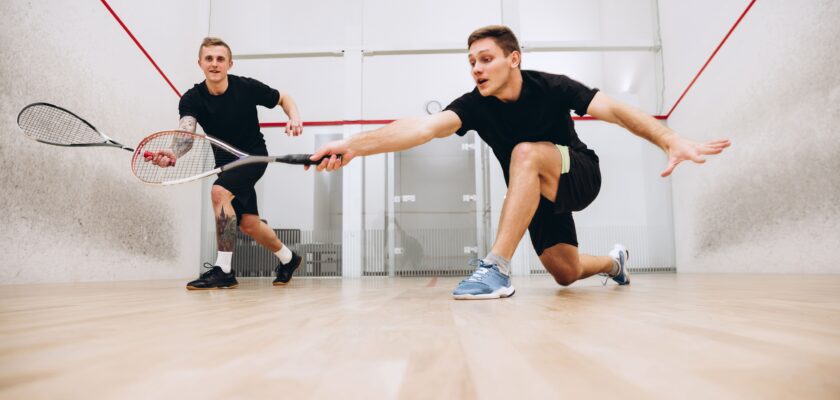Did you know that the name “squash” comes from the distinctive sound the ball makes when it is pressed against the wall? In this article you’ll learn more about this sport, as well as all squash rules!
Join the Bet7k team and get up to R$7,000 bonus on your first deposit!
Squash is a racket sport played on a closed court, involving skill, agility and strategy.
Originating in the early 19th century, the game evolved from an English sport called “rackets”, played in British prisons and schools.
Read on to find out all squash rules!
The history of squash began in England, where students at Harrow School adapted the game of rackets, adding additional walls to make the game more challenging.
The popularity of squash grew rapidly, and in 1864, the first squash court was built at Harrow School.
The sport spread throughout England and eventually the world, with clubs and courts being established in many countries.
Read on to find out all the rules of squash!

At the beginning of the 20th century, squash became a formalized sport, with the founding of several national associations and the standardization of the rules of the game.
In 1920, the Tennis, Rackets & Fives Association in England published the first official set of squash rules.
From then on, the sport continued to grow in popularity, especially in countries such as Egypt, Pakistan, Australia and the United States.
Read on to find out all squash rules!
Squash is now played at recreational and competitive levels all over the world, with international championships and a global base of enthusiasts.
The sport requires not only physical skills, but also a strong ability to make quick and strategic decisions.
Today, squash is recognized for its high level of intensity and health benefits, making it one of the most popular and challenging racket sports in the world.
Read on to find out all squash rules!
Squash rules: complete list
- Venue;
- Equipment;
- Duration;
- Score;
- Competitors;
- Infringements and penalties;
- Security;
- Training;
- Arbitration and supervision.
Squash rules: place of play
The game of squash is played on a closed court, usually with four walls. The court has specific dimensions: 9.75 meters long and 6.4 meters wide.
The front and side walls are used for hitting the ball, and there are demarcated lines that define service areas and boundaries of play.
The front wall has an upper line called the “outside line” and a lower line called the “service line”.
The court must be kept in good condition, with an appropriate floor to ensure the safety of the players.
Read on to find out all squash rules!
Squash rules: equipment
The essential equipment for squash includes the racket and the ball. Squash rackets are light, weighing between 110 and 200 grams, and have a smaller head than tennis rackets.
Squash balls are small, hollow and made of rubber, available in different colors and with different rebound levels to suit the skill level of the players.
In addition, players should wear appropriate footwear for the court, light and comfortable clothing and, preferably, goggles to prevent eye injuries.
Squash rules: duration
Squash matches can vary in length, depending on the format adopted. In official competitions, best of five games are usually played.
Each game is played until one player reaches 11 points, with the requirement of a minimum difference of two points to win the game.
If both players reach 10 points, the game continues until one player achieves a two-point lead.
Read on to find out all squash rules!
Squash rules: scoring
Scoring in squash is simple. Every time a player fails to return the ball correctly, the point is awarded to their opponent.
The score can be accumulated by both the server and the receiver. The first player to reach 11 points, with a two-point lead, wins the game.
The match continues until one player wins the required number of games to win the match.
Squash rules: competitors
A squash match is played between two players, called “competitors” or “opponents”.
In tournaments, competitors are classified and paired according to their skills and rankings.
The player who wins an initial draw has the right to choose whether to serve first or choose the side of the court.
Competitors alternate serves after each point scored, and the server must respect the service zones and lines marked out.
Read on to find out all squash rules!
Squash rules: infractions and penalties
Infractions in squash can result in penalties, such as the loss of points or services.
Common infractions include intentional obstruction of the opponent, unsportsmanlike behavior, excessive delay between points and technical faults, such as not respecting the service lines.
Depending on the severity of the infraction, the referee can issue warnings, point penalties or even disqualification of the offending player.
Squash rules: safety
Safety in squash is essential to prevent injuries. Players should wear appropriate footwear that offers support and traction.
The use of goggles is highly recommended to avoid eye injuries, especially in competitions.
Keeping the court in good condition, with no moisture or debris on the floor, is also crucial.
It’s also important for players to warm up and stretch properly before matches.
Read on to find out all squash rules!
Squash rules: training
Squash training involves developing technical skills, physical conditioning and playing strategies.
Players should practice regularly to improve their serving, returning and court movement skills. Training sessions can include endurance, agility and strength exercises.
Working with experienced coaches can help players identify areas for improvement and develop more effective tactics.
Squash rules: refereeing and enforcement
Refereeing in squash is carried out by a main referee and, in some competitions, by assistants.
The referee is responsible for ensuring that the rules of the game are followed, making decisions on points, infractions and disputes between players.
In high-level competitions, oversight can include the use of replay technologies to review controversial decisions.
The aim of refereeing is to ensure a fair and sporting game for both competitors.
Did you enjoy reading about all the rules of squash? Then read on:





